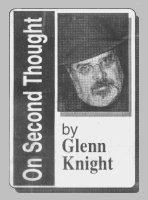
On Second Thought
by Glenn B. Knight, DNG
 The Lititz Creek is actually Carter's Run and it is named for one of the earliest local settlers, a gent from Warwickshire England (Hmm, could there be a connection here to Warwick Township?).
The Lititz Creek is actually Carter's Run and it is named for one of the earliest local settlers, a gent from Warwickshire England (Hmm, could there be a connection here to Warwick Township?).
Hammer Creek is named for the Grubb drop-hammer iron forge-the first in the new world-that was constructed along its banks. The forge was located in the wooded area just off US 322 to the left before you get to the Lebanon Pumping Station.
The Conestoga Creek, then River, was named for the Conestoga tribe of Native Americans who lived in this area.
The same is true for the Cocalico (originally Co Co Li Co) and Pequea Creeks-Indian names.
So where in the world did the Santo Domingo Creek come from? The Santo Domingo starts in the hills just above the north parking lot for the Warwick-Lititz Linear Park along Newport Road. It continues on to where Lincoln Avenue meets Cedar Street, and then on through the New Street Park, through Woodstream until it empties into Lititz Creek or Carter's Run. Got a picture of it in your mind?
When Market Street was a dirt lane from New to Cedar Streets there was a little woods and a couple of really neat ponds that were fed by the Santo Domingo. Many summers it dried up. Many springs it added to the flooding. In between there was a pleasant flow of water with pools and eddies for pre-teen boys to explore, find arrowheads and play Davy Crocket. The area is now a well for the local water supply.
Minnows were the largest of the aquatic creatures and they shared their domain with crawfish and water spiders. The woods hosted most of the fine woodland creatures and often a deer or two. As a member of the Lincoln Avenue Posse I spent a lot of time in those woods, the ponds and pools. Never once did I ever wonder why the creek was called the Santo Domingo.
I have come to learn that it was named, not actually in honor of, but because of Saunders Lovington. In the period prior to the Civil War, Saunders Lovington escaped from a plantation outside of the capital city of the Dominican Republic and found his way to Lititz.
His residence was no more than a shack set adjacent to the pleasurable little stream to provide water for cooking and bathing. He would take on odd jobs and accept payment in currency or goods. It is also reported that he could be found on the main streets of Lititz (and Warwick) playing his fiddle and dancing for coins.
The capital city of the Dominican Republic was then Santo Domingo and while Saunders Lovington was indeed an escaped slave, he was most often referred to as "The San Domingan". When travelers and newcomers inquired as to the name of the creek the local populace would most frequently say, "Why that's the San Domingan's Creek".
Long after Mr. Lovington played his last tune and his shack fell to nothing, the creek was still being referred to as the San Domingo or the Santo Domingo.
I spend hours sitting in the pavilion at the New Street Park staring into the creek looking for a crawfish or a minnow and considering that most people in Lititz don't even know the name of the creek. Those few who do know the creek's name have no idea why it's called the Santo Domingo. Mingled in with the murmur of the water spilling over the well-polished rocks I can often hear the plaintive strains of a well-rosined bow arching across a tight string of catgut.
Singing along quietly my mind drifts to another age and the sound of a fiddle in the hands of a man who most assuredly knew the meaning of freedom. "Me father and I went down to camp along with Cap'n Gooding; and there we saw the men and boys as thick as hasty pudding. Yankee Doodle came to town riding on a pony; stuck a feather in his cap and called it macaroni".
Thank you Saunders Lovington.
NOTE ADDED: The following letter to the editor appeared in the Lititz Record-Express the week following the appearance of the above.
Don--I didn't neglect to mention it. I didn't know it. Thanks for adding that information to the record. I am also glad to hear that they waited until he was dead to bury him--that was not always the case in other parts of this country. Thanks for the good info.One more thing about Saunders
Editor, Record Express,
Glenn Knight neglected to mention in last week's "On Second Thought" column that Saunders Lovington was at death, buried in the "old" or first Moravian graveyard which is situated at my back yard at 123 Spruce St.
Abraham Reinke Beck made note of this after the publication of his Moravian Graveyard book, which was published in 1905.
There are 182 people (mostly children) buried here, including Saunders - who was a black man. These burials were from 1744 until 1812.
When the church graveyard was renovated the stones were placed back indiscriminately so that the actual individual sites were lost.
Most stones are now covered with pine needles and grass and the printing is worn by the elements.
Don Rannels
Lititz
Glenn
